The traditional festival of Tu Nhien commune, Thuong Tin district, Hanoi (also known as the Chu Dong Tu – Tien Dung festival) takes place annually from the 1st of the 4th lunar month. A distinctive highlight of the festival is the Water Procession ceremony, which reenacts the legendary love story of “Chu Dong Tu meeting Princess Tien Dung.” It serves both as a ritualistic ceremony and an expression of the community’s aspiration for favorable weather and a bountiful harvest.
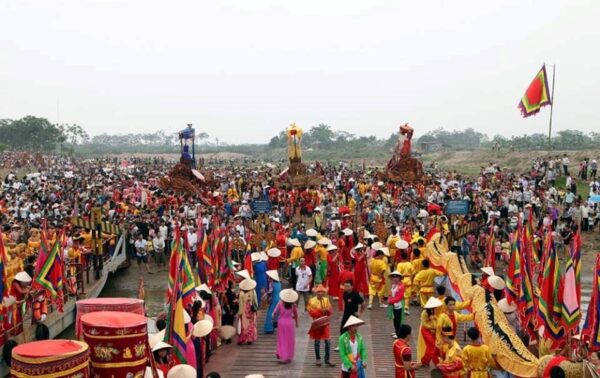
The procession of the Three Holy Immortals at the traditional Chu Dong Tu – Tien Dung festival
Chairman of the People’s Committee of Tu Nhien commune, Nguyen Xuan Phien, revealed that this year’s Chu Dong Tu – Tien Dung festival will be celebrated grandly over three days, from May 18th to 20th (corresponding to the 29th of the 3rd to the 2nd of the 4th lunar month). After a three-year hiatus due to the COVID-19 pandemic, the Party Committee, government, and residents of Tu Nhien commune are ready for the local extravaganza. To ensure the festival’s solemnity, integrity, and efficiency; to preserve and promote the cultural identity, and beliefs, and resist superstitious and divisive activities; to adhere to civilized practices in marriage, funeral rites, and festivals in Hanoi city; and to ensure safety against the COVID-19 pandemic, the People’s Committee of the commune issued Plan No. 72/KH-UBND on April 6, 2023. This plan provides guidance, management, and organization of the traditional festival in 2023, establishing an Organizing Committee, a Steering Committee, and 10 directly involved subcommittees to oversee festival activities. Additionally, special attention has been given to ensuring public order and safety, environmental hygiene, traffic management, and fire prevention in areas surrounding the festival events.
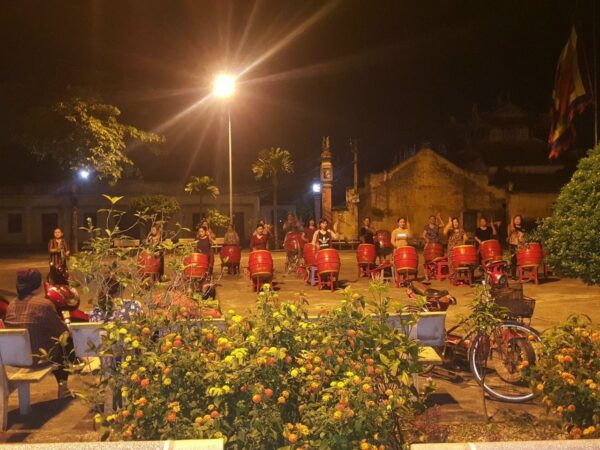
Every evening, residents light up their surroundings, enthusiastically practicing for the upcoming festival.
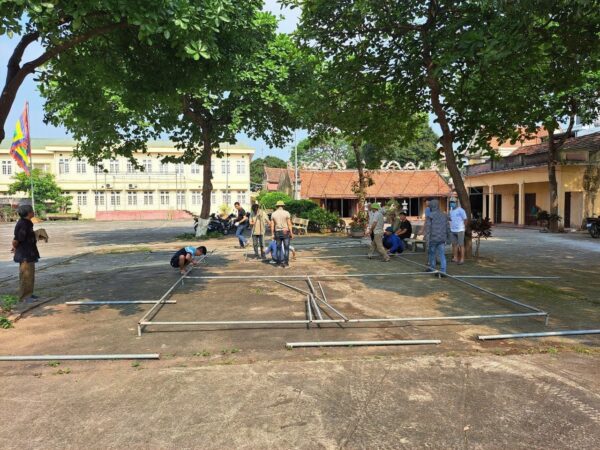
The organizing committee is diligently preparing various tasks related to the festival.
“The Chu Dong Tu – Tien Dung festival in Tu Nhien commune is a remarkable event, imbued with the enduring cultural values of the Vietnamese people in general and the riverside communities along the Red River, particularly in Tu Nhien commune. Organizing this festival requires mobilizing a large number of people, with nearly 600 participants, along with extensive preparation and training lasting an entire month,” emphasized Nguyen Xuan Phien.
The legend of the unusual love story between Chu Dong Tu and Tien Dung holds a unique place in national history. A princess adorned with golden leaves (Princess Tien Dung daughter of the 18th Hung King), possessing extraordinary beauty but having no intention of marrying, defied traditional customs and her societal position to love and connect with a poor young man, Chu Dong Tu. He was an orphan, destitute and without proper clothing, yet remarkably filial. They made a living by fishing and exchanging goods on the river, turning the place into a bustling trade center with boats and merchants.

An enchanting scene from the legendary love tale of “Chu Dong Tu meeting Princess Tien Dung” and a river cruise during the festival
Moved by the love between Chu Dong Tu and Tien Dung, a celestial being bestowed magical powers upon Chu Dong Tu. Together, they traversed the Khoai Chau region (Hung Yen) wielding a divine staff to rescue those afflicted by disasters, famine, and dire circumstances. During their humanitarian mission, Tien Dung serendipitously encountered Tay Sa (Hong Van), a princess from the Western Palace who had descended to the mortal realm. They formed a sisterhood, and Tien Dung orchestrated a fateful connection with Chu Dong Tu, embarking on a joint mission to better the lives of others. Tay Sa, adept in magical spells using the divine staff and the fairy hat, constructed a palace adorned with precious pearls and treasures, with silk curtains and flower-patterned blankets. Everywhere they went, they opened their arms wide to aid those in need, guide the suffering, and illuminate paths for a better life.
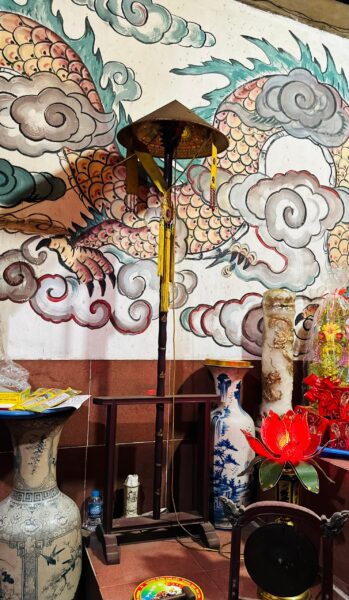
The legendary divine staff and fairy hat, as per folklore, are carefully preserved by the locals in the village communal house.
When the king fell seriously ill, Chu Dong Tu and Tien Dung secretly sought the assistance of Tay Sa to cure the king. With the magical remedy, the king swiftly recovered, and Tay Sa was honored as the “Princess of the Buddhist Land.”
Some flatterers falsely reported to Hung King that the couple, Chu Dong Tu and Princess Tien Dung, were using miraculous powers to build their own realm and intended to establish a separate domain. Suspecting rebellion, Hung King dispatched his forces to quell the perceived uprising. Unable to resist their father’s decree, Chu Dong Tu and Tien Dung awaited their fate. On a tumultuous night, a fierce storm arose, causing the entire fortress of Chu Dong Tu to soar into the sky, leaving behind a vast expanse of water. Subsequent generations referred to this expanse as the Nhat Da Swamp (One-Night Swamp.) The location where Chu Dong Tu concealed himself is now situated in Tu Nhien commune, Thuong Tin district, Hanoi. Currently, Tu Nhien commune, Thuong Tin district, Hanoi boasts two nationally recognized historical and cultural sites: the Ha Communal House and the Thuong Communal House, along with the Gia Ngu area. This ensemble constitutes the historical relics dedicated to Chu Dong Tu, Princess Tien Dung, and Princess Hong Van.
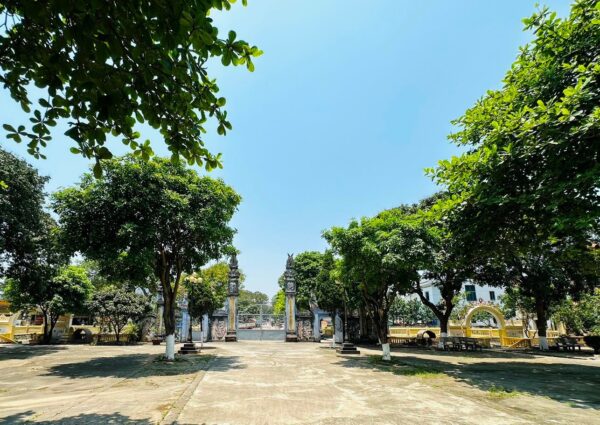
National-level historical and cultural relics: Ha Communal House – Thuong Communal House and Gia Ngu Area in Tu Nhien Commune
The Chu Dong Tu – Tien Dung festival in Tu Nhien commune encompasses rituals such as the water and palanquin processions, featuring the eight-panel flag, incense rituals, processional palanquins, lantern processions, etc. The water procession involves a ceremonial boat journey on the Red River, scooping water into a ceremonial jar, and bringing it back for sacred rituals. Elders in the community emphasize that the water procession not only symbolizes the wish for favorable weather and prosperity but also reflects profound religious beliefs, commemorating Saint Chu Dong Tu and his occupation as a skilled fisherman navigating the river.
The palanquin procession, conducted with grandeur in accordance with traditional customs, is a ceremonious affair filled with symbolic elements like vibrant drums and gongs, fluttering flags, colorful banners, melodious music from the eight-tone musical scale, and lyrical melodies.

The palanquin procession route extends from the village communal house to the Gia Ngu area, culminating at the fairy princess’ beach.
On the main festival day, people enthusiastically process right from the village communal house through residential clusters No. 2 and No. 1 to the Gia Ngu area to the fairy princess’ beach. Here, the procession collects water to purify the ceremonial palanquin and reenacts the legendary love story of “Chu Dong Tu meeting Princess Tien Dung” with a river cruise. Next is the procession of Saint Chu Dong Tu and his two wives along with the festival’s rituals to the Gia Ngu area, before concluding with the procession of the Three Saintly Immortals to the village communal house.
According to Mr. Nguyen Van Dinh, Head of the Festival Organizing Committee at Ha Communal House – Thuong Communal House, Tu Nhien Commune, the village communal house in Tu Nhien is dedicated to venerating the Sacred Saint Chu Dong Tu (one of the “Four Immortals”), Princess Tien Dung, Princess Hong Van, and General Dao Thanh of the Hai Bà Trưng Queens. The temple, built in 1702, was designated as a National Heritage Site in 1988. Legend has it that during the procession of the Three Saintly Immortals when they depart, Princess Hong Van (Princess Tay Sa) leads the way to clear the path. Upon their return, Princess Hong Van again takes the lead, ensuring arrangements for bedding, dining, accommodation, and the safety of Chu Dong Tu and Tien Dung.
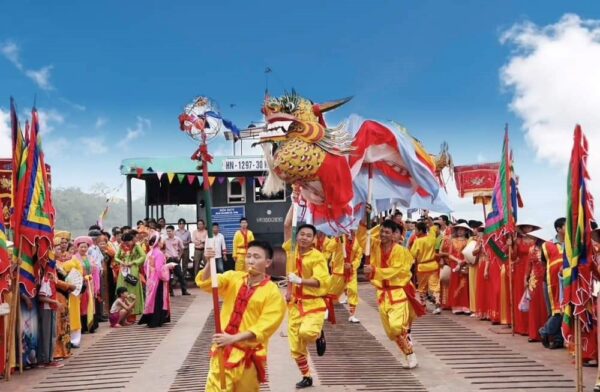
Dragon dance at the Festival
Within the framework of this year’s festival, the organizing committee will showcase rituals and processions, and conduct traditional cultural and artistic activities, including dragon dances, flag dances, and traditional dances at the Gia Ngu area and the communal house courtyard. This aims to immerse the residents and international visitors in the festival, bringing them back to the timeless cultural setting, a vivid tableau of the rich and dynamic life of the Vietnamese people in the Red River Delta for thousands of years. This contributes to the preservation, promotion, and utilization of cultural values linked to the development of tourism and the local socio-economic landscape.
According to legend, Chu Dong Tu hailed from the village of Chu Xa (now part of Van Duc commune, Gia Lam district, Hanoi). One day, Mrs. Bui Thi Gia dreamt of a celestial being gifting her a copper coin and sensed that she was pregnant. Come autumn, she gave birth to a son, whom she named Dong Tu, signifying the fulfillment of that dream. The young man, born into the impoverished Chu family, embodied the karmic union of three lifetimes, characterized by intense flames and a heart generous, tolerant, and benevolent amidst the parents, Mr. Chu Toa Van and Mrs. Bui Thi Gia.
Chu Dong Tu possessed intelligence, a respectful nature, and filial piety. At the unfortunate age of 13, tragedy struck with his mother’s untimely death and a devastating house fire, leaving the family destitute with only a piece of cloth. During each occasion of going out, father and son would take turns wearing it. When his father fell seriously ill and faced imminent death, he instructed Dong Tu: “In the cycle of human existence, whether in abundance or poverty, wealth or destitution, everything is within the will of the heavens. Our family, once affluent and now impoverished, is also the will of the heavens. Therefore, it cannot be changed. Now, with my impending demise, it’s predetermined by fate. When I’m gone, keep this piece of cloth to cover yourself, sparing the world from mockery.” Faced with such circumstances, Chu Dong Tu could only embrace his father’s remains, lamenting, “The debt of nurturing has not been repaid, and our family’s situation is now dire. How can I repay the kindness of my parents in such circumstances?” Believing that as long as he survives, heaven will not forsake his earnest heart, and attire will come by abundantly, he dressed his father in a piece of cloth and gave him a proper burial.
From that moment onward, Chu Dong Tu lived without clothing. Each day, he concealed himself beneath the river’s surface, using it as a makeshift covering. Seeing many boats of merchants trading, he fashioned himself as a river wanderer, begging for sustenance. Additionally, he fished and caught crabs to eke out a living.
In the bygone era of the 18th Hung King, there was a daughter named Tien Dung. At eighteen, she possessed exquisite beauty but harbored no intention of marriage. Her heart inclined towards exploration, venturing to the scenic wonders of the country. The king, her father, indulged her whimsical excursions. Annually, in the second and third months, the princess sailed her boat along the Red River towards the direction of the Chu Xa village (now part of Van Duc commune, Gia Lam district, on the outskirts of Hanoi).
On one fine day, Princess Tien Dung’s boat glided along the Red River. At that moment, Chu Dong Tu immersed himself in the river, catching fish. Witnessing a fleet of sailboats approaching from a distance, he, in fear, hastily ran ashore, concealing himself amidst the coconut palms buried in the sand. Appreciating the picturesque scenery, Princess Tien Dung ordered the boat to stop and sent her maids ashore to set up a bathing curtain near a clump of coconut palms. Unbeknownst to her, it was precisely where the young man from the Chu family hid. As water splashed, the sand flowed, and in an instant, she glimpsed the figure of a young man devoid of clothing. Frightened, Chu Dong Tu contemplated fleeing. After a moment of fear, he recounted his arduous life to her. Having heard his tale, the princess declared, “I had vowed not to marry, but it seems fate has intertwined our destinies.” Right then, Tien Dung transmitted clothing to Chu Dong Tu and, together, they performed the marriage ceremony on the boat.
Upon learning that his daughter had wedded a poor man, Hung King erupted in anger, disowning her. Tien Dung, witnessing this, dared not return and chose to live a simple yet happy life with Chu Dong Tu. They earned a livelihood through fishing and bartering goods on the river. The place transformed into a bustling hub, with boats engaged in bustling trade. Admiring the affection between Chu Dong Tu and his wife, a celestial being bestowed divine powers upon Chu Dong Tu. They traversed the Khoai Chau region with a magic staff, rescuing those afflicted by disasters, hunger, and disease. On their humanitarian journey, Tien Dung serendipitously encountered Tay Sa, a princess from the West, who had renounced her celestial status. They became sworn sisters, subsequently orchestrating a destined encounter for Chu Dong Tu, tgether aiding humanity. Tay Sa, proficient in magical spells, utilized her magic staff and celestial hat to construct a palace adorned with pearls and a treasury brimming with riches, luxurious fabrics, and floral tapestries. When the king fell seriously ill, Chu Dong Tu and Tien Dung secretly sought Tay Sa’s assistance in healing him. Cured by the magical medicine, the king bestowed upon Tay Sa the title “Princess of the Buddhist Land.”
Some flatterers informed Hung King that Princess Tien Dung and her husband, through miraculous feats, were constructing their own realm, aspiring to establish an independent domain. Suspecting a rebellion, Hung King dispatched his military commanders to suppress the perceived uprising. The couple, Chu Dong Tu and his wife dared not resist the king’s command, patiently awaiting their fate. On a tumultuous night, a fierce storm arose, causing the entire fortress of Chu Dong Tu to soar into the sky, leaving behind a vast expanse of water. Subsequent generations referred to this expanse as the Nhat Da Swamp (One-Night Swamp.) The location where Chu Dong Tu concealed himself is now situated in Tu Nhien commune, Thuong Tin district, Hanoi.
Legend has it that after Chu Dong Tu and Tien Dung ascended to the heavens, Hung King Due Vuong arrived at his daughter’s former abode. Filled with remorse and missing his daughter, the king posthumously honored Chu Dong Tu with the title Chu Cong and erected a temple in his honor.
This folklore not only recounts a beautiful love story but also extols the significant contributions of the couple, Chu Dong Tu and Tien Dung, in rescuing the people from illnesses, disasters, and hardships. Wherever they went, they extended their helping hands to assist those in need, guiding them towards a better life. It is for these reasons that Chu Dong Tu is revered by the people as one of the “Four Immortals,” with profound respect and devotion.

